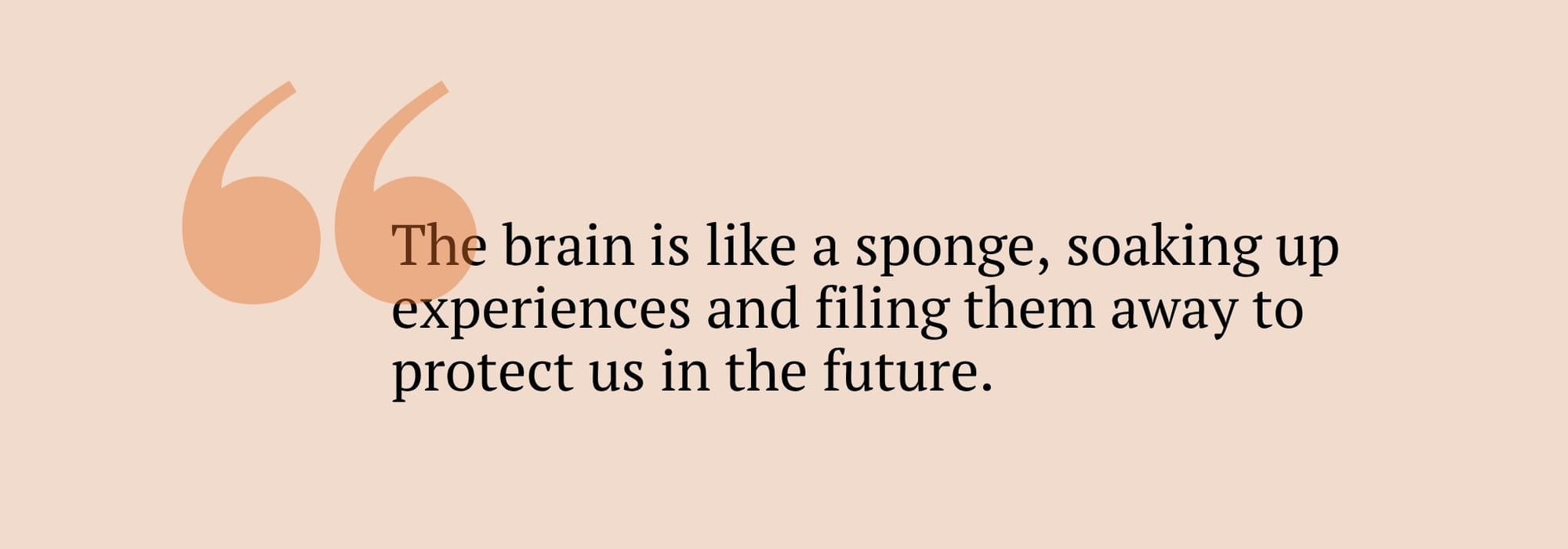When your brain wants you to stay safe, sometimes it plays games with you…
I love nothing more than going to bed on a Friday night knowing that I can allow myself to wake up naturally the next morning. After five consecutive days of rising to the sound of an alarm, it really is one of my favourite parts of the week. But, every so often, I sleep in later than intended – and when I roll over to see that it’s almost midday, I feel dread creeping in. My head starts to spiral, and my internal critic labels it a failure because I’ve ‘wasted the day’ – essentially writing it off before it’s even begun.
This is an example of the domino mindset, a form of ‘cognitive bias’ towards negative events. Perhaps you’ve experienced something similar on a day out with friends – you’re having fun, until you accidentally spill some ketchup on your new shirt, and from that moment onwards, you’re unable to enjoy yourself. In fact, it seems like things are destined to go wrong after that point – your dessert is disappointing, you say something you instantly regret – like dominos falling one by one.
What exactly is a domino mindset?
Dr Julie Smith states that the ‘domino mindset’ is a term she uses for “a cognitive bias that most clinicians call overgeneralisation”. This means, taking one single event (like when you accidentally sleep late or ruin your favourite shirt) and using it to judge past events or predict the future, drawing conclusions that aren’t always actually justified.
Cognitive bias is a normal filtering process that enables your brain to prioritise and process large amounts of information quickly. “The brain is like a sponge, soaking up experiences and filing them away as something to learn from to protect us in the future,” explains counselling psychologist Dr Tara Quinn-Cirillo. “So, when we face difficult situations in the future, the brain can access a data bank of information that potentially keeps us safe.”

Essentially, humans are naturally wired to look for patterns as a form of survival. But overgeneralisation, AKA the domino mindset, is a cognitive distortion that doesn’t look for patterns – it creates them.
Connecting the dots
You’ve probably observed this kind of behaviour in someone you love. They get a rejection email after a job interview, and make the sweeping generalisation: “No one will ever hire me.” Or the friend who is going through another break-up, and insists: “Everyone I love leaves me.”
This is simply a primitive defence mechanism playing out in a modern world, where we treat a non-threatening event as life-threatening. Our brains become so overcome by fear that we don’t see things as they actually are. “We can’t create any space for perspective, and to consider if the thought relates to a real threat,” explains Dr Quinn-Cirillo. “If we continually respond in this automatic way, we create an ongoing loop of thought-response which can be exhausting, and keeps us stuck in threat mode.”
Although anyone can experience the domino mindset, one study, published in the journal Biological Psychiatry, observed that those with generalised anxiety disorder are more likely to have a tendency towards overgeneralisation, registering safe encounters as fearful.
If you notice yourself using words like ‘always’ and ‘never’ in a context that isn’t actually true, you may be overgeneralising. This isn’t necessarily the end of the world, but if you worry that you have a negative outlook on life, then this could be the sign you have been waiting for to make some changes to the way you think.
This doesn’t mean trying to erase these thoughts or shoving them down, instead, it’s about recognising that the thoughts you have (about ‘never’ getting hired, or ‘always’ being rejected) are just that – thoughts. “We often automatically believe that what we think is fundamentally true,” says Dr Quinn-Cirillo. “It can be a liberating concept to know that thoughts aren’t facts.”
Addressing the domino mindset
Identifying the thoughts that could potentially trigger a collapse of all your dominos is the first step, as this gives you an opportunity to think clearly about how to respond, instead of reacting out of fear.
“Strategies like talking our thoughts out aloud when they happen can help us realise that we are simply having a thought, and this helps create some distance from it. It also allows us time to think about whether we need to respond,” Dr Quinn-Cirillo says.

So, the next time you stub your toe, or your work nemesis talks over you in a meeting, remembering to take a second to pause can make a world of difference. “Taking a slow, simple breath in through the nose, and out through our mouth, can help ground us in the here and now, when our brain is busy predicting possible threats and future outcomes, or trawling for evidence in our past experiences,” says Dr Quinn-Cirillo. “This can help regulate our physiological response to negative thinking, and our emotional response, too. Allowing for better, more considered action, rather than anxiety or fear-based responding.”
During this brief pause, the trick is to practise investigating your thoughts a little deeper. “Take a moment to think: is there any evidence for this thought? If you were in court, what evidence (if any) would be presented to support it?” suggests Dr Quinn-Cirillo. This exercise of looking objectively at your thoughts can flag any biases that you may have. For example, do you often catastrophise or compare your situation to others? Are you prone to ‘black and white’ thinking? Instead of choosing to believe that the day is ruined because you have ketchup on your shirt, is there a thought that can support a more neutral response?
It’s important to note that although you may be aware of your domino mindset, it can be difficult to disengage from the thought patterns, because they are so deeply ingrained, based on how our experiences of adversity in childhood, adolescence, and beyond have shaped our personal beliefs. Give yourself grace, be patient, and, if you need support, reach out to a trained therapist or counsellor for guidance.
If you find yourself able to spot the thoughts, but can’t quite shift your mindset in the moment, make a note of the thought and come back to it later. “Write the problematic thought down on paper with an actual pen,” says Dr Quinn-Cirillo. “This can often look and feel very different to when it is in our heads.”
Going forward, it might just be that you can spot the tricks your mind is playing on you before the next domino falls.


Comments